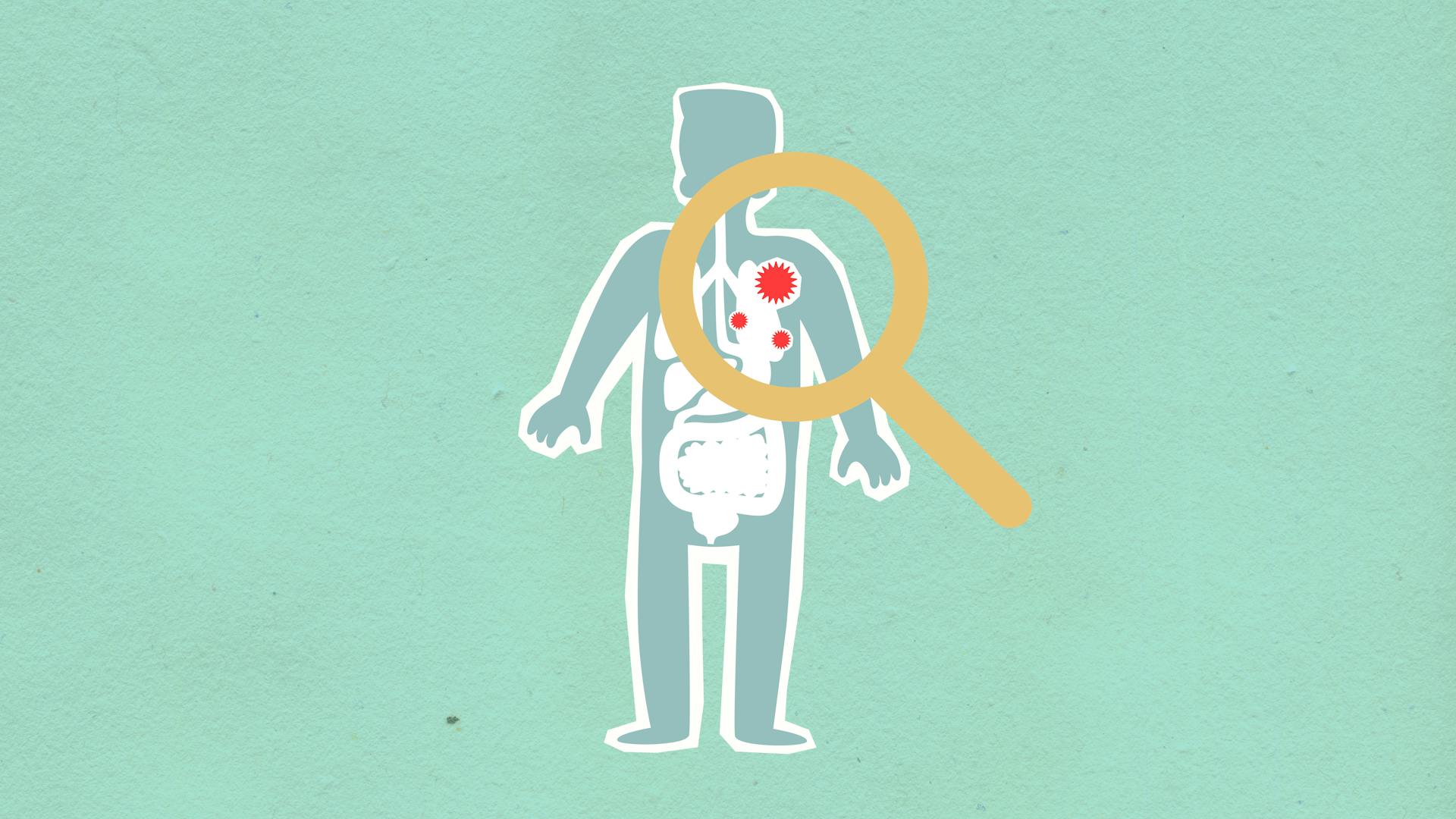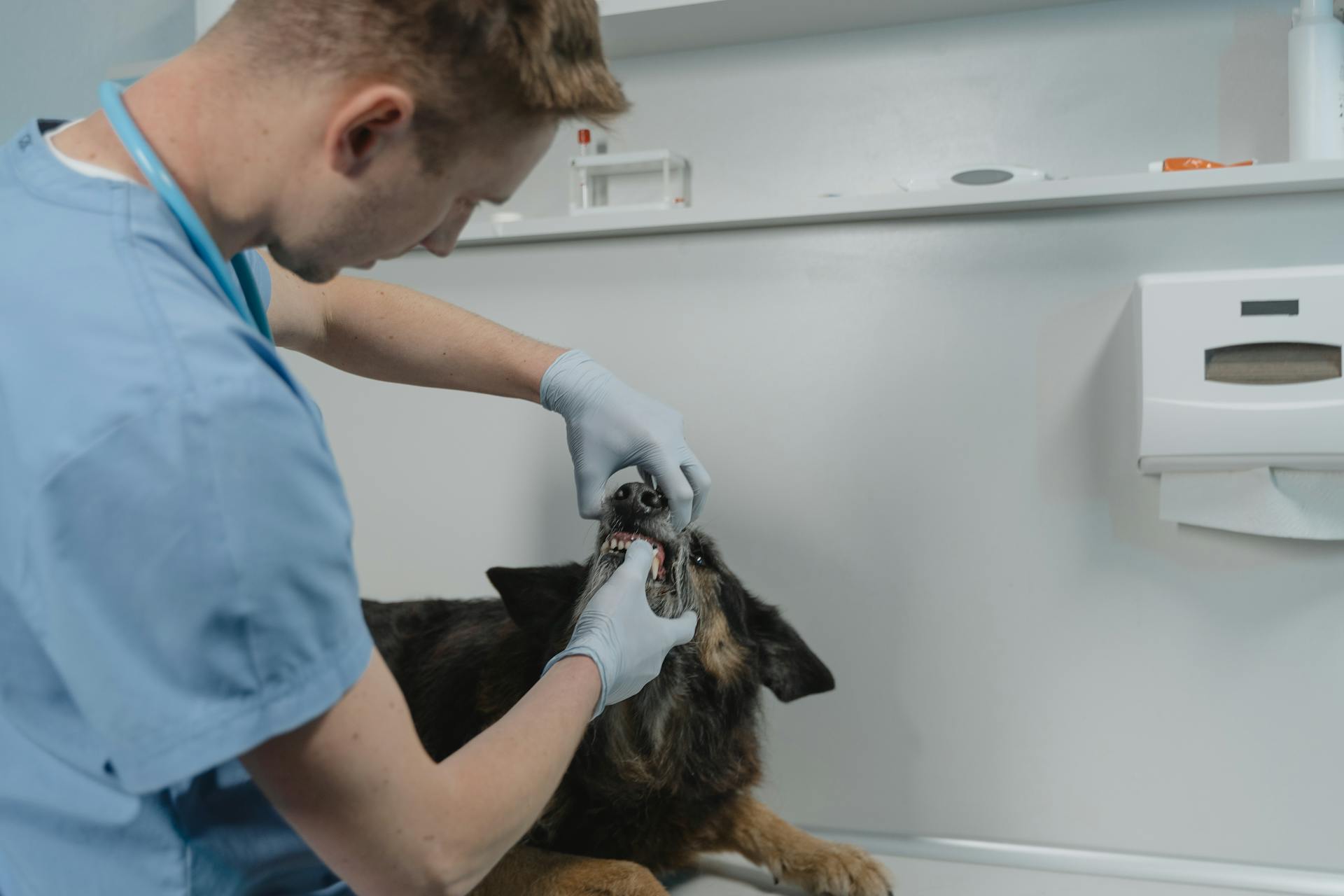
Dog liver diseases can be a serious health issue for our furry friends. Liver disease in dogs can be caused by a variety of factors, including genetics, infections, and exposure to toxins.
Some common symptoms of liver disease in dogs include yellowing of the skin and eyes, vomiting, and loss of appetite. These symptoms can be subtle at first, but can quickly progress to more severe health issues if left untreated.
The liver plays a crucial role in filtering toxins from the blood, and when it's not functioning properly, these toxins can build up and cause damage to other organs. Liver disease can also cause a decrease in the production of bile, which is essential for digestion.
If you suspect that your dog is suffering from liver disease, it's essential to seek veterinary care immediately. Early diagnosis and treatment can make a significant difference in the outcome.
Suggestion: Embark Dog Dna Test Breed & Health Kit
Causes of Liver Disease
Liver disease in dogs can be caused by a variety of factors, including genetics, infections, and toxins. Certain breeds like Labrador Retrievers, Cocker Spaniels, and Doberman Pinschers are more prone to developing liver diseases due to genetic predispositions.
Infections like Canine Infectious Hepatitis and leptospirosis can cause liver malfunction and damage. Viral or bacterial infections can be prevented with vaccinations.
Hepatitis, including chronic active hepatitis and autoimmune disorders, can cause inflammation and damage to the liver. Conditions like diabetes and pancreatitis can also contribute to secondary liver dysfunction in dogs.
Toxins like aflatoxins, produced by mold, can cause liver damage in dogs. Contamination of dog food with aflatoxins can lead to liver damage. Dogs are curious by nature, so it's essential to monitor their environment for potential toxins.
Some substances, including certain medications, plants, chemicals, and other toxic substances, can be toxic to the liver and cause liver damage. Heavy metals, herbicides, fungicides, insecticides, rodent poisons, and certain mushrooms can cause life-threatening liver damage.
Here are some common causes of liver disease in dogs:
- Genetic predispositions (e.g. Labrador Retrievers, Cocker Spaniels, Doberman Pinschers)
- Infections (e.g. Canine Infectious Hepatitis, leptospirosis)
- Toxins (e.g. aflatoxins, heavy metals)
- Hepatitis (e.g. chronic active hepatitis, autoimmune disorders)
- Other diseases (e.g. diabetes, pancreatitis)
Symptoms and Diagnosis
Symptoms of liver disease in dogs can be challenging to identify, as the liver is a resilient organ that can compensate for damage until a significant portion of its function is compromised. Approximately 75-80% of the liver needs to be dysfunctional to produce clinical signs.
Changes in appetite can be a subtle symptom of liver disease, ranging from a loss of interest in food to increased hunger. Dogs may also experience vomiting or diarrhea.
Jaundice, or yellowing of the skin and eyes, is a common sign of liver disease. This can be a subtle indicator, and pet owners must be vigilant in monitoring their dog's behavior and overall well-being.
The following symptoms may indicate liver disease in dogs:
- Changes in appetite
- Jaundice (yellowing of the skin and eyes)
- Increased thirst and urination
- Ascites (accumulation of fluid in the abdomen)
- Neurological signs (disorientation or unusual behavior)
- Vomiting and/or diarrhea
- Discolored urine
- Seizures
- Changes in stool color
Accurate diagnosis of liver disease is critical for effective treatment. A combination of tools and techniques, including physical exams, blood tests, imaging studies, and liver biopsies, can help assess the liver's structure, function, and overall health.
Identifying the Symptoms
Identifying the symptoms of liver disease in dogs is crucial for prompt and effective treatment. The liver is a very stoic and resilient organ, where approximately 75-80% of the liver needs to be dysfunctional to produce clinical signs.
Symptoms of liver dysfunction may include lethargy, loss of appetite, weight loss, vomiting and/or diarrhea, increased thirst and urination, jaundice (yellowing of the skin and whites of the eyes), discolored urine, ascites (accumulation of fluid in the abdomen), and neurological signs (disorientation or unusual behavior).

Changes in appetite can be a subtle indicator of liver disease in dogs, ranging from a loss of interest in food to increased hunger. Affected animals may experience vomiting or diarrhea.
Jaundice is a common sign of liver disease, but it may not be immediately noticeable. Yellowing of the skin, gums, and the whites of the eyes can be indicative of liver failure.
Here are some common symptoms of liver disease in dogs:
- Lethargy
- Loss of appetite
- Weight loss
- Vomiting and/or diarrhea
- Increased thirst and urination
- Jaundice (yellowing of the skin and whites of the eyes)
- Discolored urine
- Ascites (accumulation of fluid in the abdomen)
- Neurological signs (disorientation or unusual behavior)
How Is Diagnosed?
Diagnosing liver disease in dogs requires a combination of tools and techniques.
A detailed physical exam by your veterinarian is the first step in diagnosing liver disease in dogs. They will evaluate your dog for signs of liver issues such as jaundice, enlarged liver, and changes in behavior.
Blood tests are usually the next step in diagnosing liver disease in dogs. These tests can check for elevated liver enzymes, which indicate liver stress or damage.
Imaging studies, such as ultrasound, offer a non-invasive way to visualize the liver and detect abnormalities like swelling, tumors, or evidence of trauma. This imaging technique can be essential in understanding the extent and nature of liver damage.
Consider reading: Diagnosing Hypothyroidism in Dogs

A liver biopsy may be necessary for a definitive diagnosis. This procedure involves taking a small tissue sample from the liver for microscopic examination.
Blood tests can also check for anemia, infection, or inflammation, and evaluate liver enzymes, bilirubin, and other markers. Laboratory tests help veterinarians diagnose and treat liver disease in dogs.
Coagulation tests, such as PT and aPTT, provide insights into the liver's role in blood clotting. Abnormalities may suggest impaired function of the liver.
Ultrasound imaging is commonly used to visualize the liver's structure, size, and blood flow. It helps identify abnormalities such as tumors, cysts, or changes in liver texture.
Discover more: Dog Lab Tests
Treatment and Prevention
Treatment for dog liver disease depends on the underlying cause and severity of the condition, but dietary management and nutritional support are foundational. A diet low in sodium and rich in high-quality proteins can help reduce the liver's workload.
Medications, such as antibiotics and urosodiol, may be used to treat bacterial infections and promote bile flow. Corticosteroids, like prednisone, may also be prescribed to manage the disease.
For more severe or specific liver conditions, surgical interventions may be necessary, including surgery to remove blockages or tumors.
Preventing liver disease in dogs involves a multifaceted approach, including vaccinations, proper diet, and environmental management. Reducing exposure to toxins, such as household cleaners and pesticides, is essential, and ensuring your dog doesn't have access to potentially harmful substances can significantly lower the risk of liver damage.
A balanced and nutrient-rich diet, regular exercise, and proper hydration are also crucial in maintaining a liver-friendly lifestyle for dogs. Regular check-ups with your veterinarian, especially as your dog ages, can help detect health issues early on.
Here are some practical tips for maintaining a liver-friendly lifestyle for dogs:
- Balanced and Nutrient-Rich Diet
- Regular Exercise
- Proper Hydration
- Regular Check-ups with Your Veterinarian
- Parasite Control Program
- Stay Up-to-Date with Vaccinations
- Be Aware of Potential Toxins in Your Dog's Environment
Treatment Options for Dysfunction
Dietary management and nutritional support are key components in treating liver disease in dogs. A diet low in sodium and rich in high-quality proteins can help reduce the liver's workload.
Supplements like SAM-E (denosyl or denamarin) and milk thistle are often recommended for their liver-protective properties and ability to promote liver regeneration. These supplements can aid in the liver's healing process.
On a similar theme: Canine Cancer Supplements

Medications also play a critical role in treatment. Antibiotics may be used if a bacterial infection is present, and urosodiol can help move bile through the liver more freely and easily.
Surgical interventions may be necessary for more severe or specific liver conditions, such as surgery to remove blockages or tumors. In cases of liver shunts, a procedure to correct the abnormal blood flow may be required.
Veterinarians may recommend special prescription diets to support liver function, which typically have controlled levels of high-quality proteins, reduced copper content, and increased levels of certain nutrients.
Here are some common medications used to treat liver disease in dogs:
- Antibiotics for bacterial infections
- Urosodiol to improve bile flow
- Corticosteroids like prednisone to manage the disease
- Anti-inflammatory drugs to reduce inflammation
Regular veterinary check-ups are essential to assess the effectiveness of the treatment and make adjustments as needed. Every dog is unique, and what works for one may not work for another.
Serious Complications
Liver disease in dogs can lead to serious complications if left untreated.
If liver disease is not addressed, it can critically impact a dog's health and well-being.
Some of the most serious complications include liver failure, which can cause a buildup of toxins in the body, and liver cancer, which is a common cause of death in dogs with liver disease.
Hepatic encephalopathy, a condition where the liver's inability to detoxify the blood leads to brain damage, is another serious complication.
Liver disease can also cause a range of other problems, including gastrointestinal bleeding, jaundice, and coagulopathy.
Prevention Methods

Preventing liver disease in dogs is crucial to their overall health and well-being. A multifaceted approach is necessary, including vaccinations, proper diet, and environmental management.
Vaccinations are a crucial part of preventing liver disease in dogs. Keeping your dog up-to-date with vaccinations can prevent diseases like infectious hepatitis and leptospirosis.
A balanced diet is essential for preventing certain types of liver disease. Providing a diet rich in essential nutrients while avoiding foods toxic to dogs is key.
Avoiding toxic foods is vital. Foods to avoid include onions, grapes, raisins, chocolate, and certain artificial sweeteners like xylitol.
Regular exercise is also important for maintaining a healthy weight and overall well-being. Obesity is a risk factor for various health issues, including liver disease in dogs.
Ensuring your dog has access to clean and fresh water at all times is also crucial. Proper hydration supports various physiological functions, including those of the liver.
Intriguing read: Dog Health News

Regular parasite control programs can also help prevent infestations of internal parasites, which can contribute to liver disease.
Here are some key prevention methods to consider:
- Feed a high-quality, balanced diet that meets your dog's nutritional needs.
- Avoid feeding human foods toxic to the liver, such as chocolate, grapes, and raisins.
- Encourage regular exercise to maintain a healthy weight.
- Ensure access to clean and fresh water at all times.
- Implement a regular parasite control program.
- Stay up-to-date with vaccinations.
- Be aware of potential toxins in your dog's environment and store them securely.
- Schedule regular check-ups with your veterinarian.
- Consider routine blood tests to monitor liver function.
Therapeutic Approach
Immunosuppressive therapy is a common approach to treating chronic hepatitis in dogs. Corticosteroid therapy with prednisone/prednisolone is often used to prolong survival, improve hepatic histologic changes, and induce remission.
Adjunctive immunosuppressive therapy, such as leflunomide, can be added for steroid-sparing effects and/or additional immunosuppression to achieve disease remission. A repeat liver biopsy is the best way to determine remission, but serial monitoring every 2 weeks for normalization or marked reduction of alanine transaminase activity can be used as a surrogate marker.
Antioxidant therapy is also used to reduce hepatic injury and fibrosis in dogs with chronic hepatitis. Glutathione, a potent antioxidant, has been reported to be decreased in dogs with necroinflammatory liver disease.
Vitamin E, S-adenosylmethionine, silibinin, N-acetylcysteine, and ursodeoxycholic acid are antioxidants commonly used as ancillary treatments in dogs with chronic hepatitis. These nutraceuticals show inhibition of hepatic stellate cell activation, protection of hepatocytes from apoptosis, and attenuation of experimental liver fibrosis.
Worth a look: Are Therapy Dogs Service Animals

Protein restriction is a treatment option for dogs with chronic hepatitis, but it should be limited to the maximum tolerated level that prevents signs of hepatic encephalopathy. Diets that contain moderate amounts of protein, such as prescription renal diets and geriatric diets, may be suitable alternatives to a prescription liver diet.
Anticopper drug therapy is generally reserved for cases with documented primary or secondary excess copper accumulation. The chelator, penicillamine, is typically used, and has additional anti-inflammatory and antifibrotic effects.
For more insights, see: Protein in Female Dog Urine
Understanding the Role and Anatomy
The liver in dogs is a crucial organ that plays a vital role in their overall health. It's the largest internal organ, located in the abdomen, and is responsible for detoxification, metabolism, and aiding in digestion.
Every bite your dog takes passes through the liver, making sure harmful substances are removed and nutrients are effectively processed. The liver produces bile, which is vital for the breakdown and absorption of fats in the small intestine.
The liver's ability to filter out toxins from the bloodstream is paramount, and it plays a significant role in metabolizing proteins, fats, and carbohydrates, converting them into usable energy and nutrients.
Take a look at this: My Dog Plays Too Rough with Other Dogs
Breed-Specific Conditions
West Highland White Terriers, Skye Terriers, Labrador Retrievers, and Doberman Pinschers are breeds predisposed to chronic hepatitis, a condition that can be caused by various factors including copper accumulation.
West Highland White Terriers can accumulate excessive hepatic copper, but not all dogs with high copper concentrations develop hepatitis. Some dogs with high copper concentrations die of old age without liver lesions.
Labrador Retrievers can develop a primary lymphoplasmacytic hepatitis that involves immune-mediated mechanisms, in addition to a copper-associated hepatopathy. Treatment decisions for Labrador Retrievers rely on liver biopsy findings and tissue copper quantification.
Doberman Pinschers are prone to an idiopathic chronic immune-mediated hepatitis, which can involve copper retention in some cases.
Here's a list of breeds and their associated chronic hepatitis conditions:
Early diagnosis and treatment are crucial for managing chronic hepatitis in these breeds, as they can achieve remission with the right care.
West Highland White Terrier
West Highland White Terriers are prone to a condition called chronic hepatitis, which can be associated with high tissue copper concentrations. This condition can lead to symptoms such as anorexia, nausea, vomiting, diarrhea, and jaundice.

Affected dogs may also develop ascites and increased liver enzymes. The severity of liver injury can advance to cirrhosis if left untreated.
Interestingly, West Highland White Terriers with chronic hepatitis often have lower overall hepatic copper concentrations compared to Bedlington Terriers with copper storage hepatopathy.
Maximal copper accumulation in West Highland White Terriers occurs by 6 months of age and may then decline.
Labrador Retrievers
Labrador Retrievers are predisposed to chronic hepatitis, which can be caused by pathological accumulation of hepatocellular copper or immune-mediated mechanisms.
Jaundice, inappetence, vomiting, lethargy, and weight loss are common clinical features of chronic hepatitis in Labrador Retrievers.
Labrador Retrievers with chronic hepatitis often have a normal PCV, leukocytosis, increased ALT, increased ALP, and hyperbilirubinemia.
Ultrasonographic imaging may demonstrate hypoechoic and hyperechoic parenchymal nodules, subjective microhepatica, and irregular liver margins and ascites in Labrador Retrievers with chronic hepatitis.
Treatment decisions for Labrador Retrievers with chronic hepatitis are based on liver biopsy findings, and copper chelation and restricted copper intake can establish complete remission in dogs with overt copper overload.
Labrador Retrievers with chronic nonsuppurative immune-mediated hepatitis not associated with hepatic copper retention are treated lifelong as for idiopathic chronic hepatitis, and response to treatment can be dramatic if diagnosed early.
A unique perspective: Fat Labrador Dog
Doberman Pinschers
Doberman Pinschers are prone to a specific type of liver disease known as idiopathic chronic immune-mediated hepatitis.
This condition predominantly affects middle-aged adult female Doberman Pinschers and can lead to severe symptoms such as anorexia, weight loss, and jaundice.
Copper retention appears to play a role in some dogs with this condition.
In dogs with advanced disease, ultrasonography may identify nodular liver lesions.
Treatment typically involves immunomodulation with prednisone and antioxidants, which can be effective in inducing remission.
However, the prognosis is poor for dogs with advanced nonsuppurative hepatitis.
Early diagnosis and treatment can improve the chances of a good outcome, especially if the disease is caught early.
Discover more: Doberman Pinscher Hip Dysplasia
Cocker Spaniel
The Cocker Spaniel is a popular breed known for its gentle and affectionate nature. They are a medium-sized dog with a sturdy build and a beautiful, flowing coat.
Their ears are long and hanging, which can make them prone to ear infections if not properly cleaned and cared for. Regular ear cleaning is essential to prevent infections.
Cocker Spaniels are also prone to eye problems, including cataracts and progressive retinal atrophy. These conditions can lead to blindness if left untreated.
They are generally a healthy breed, but like all breeds, they can be susceptible to certain health issues. Regular veterinary check-ups and a balanced diet can help prevent or manage these issues.
Their short noses can make breathing difficult, especially in hot or humid weather. This is something to consider when exercising or playing with your Cocker Spaniel in extreme temperatures.
Cocker Spaniels are highly social dogs and thrive on human interaction. They require regular exercise and mental stimulation to prevent boredom and destructive behavior.
For more insights, see: Why Are Cocker Spaniels Tails Docked
Skye Terriers
Skye Terriers are prone to chronic hepatitis, a condition that can range from being clinically normal to end-stage liver failure.
The disease can manifest in three separate liver disorders: mild inflammation with no evidence of cirrhosis or copper accumulation, advanced macronodular cirrhosis with cholestasis, and marked copper accumulation.
If your Skye Terrier is diagnosed with chronic hepatitis, treatment will be based on the underlying disorder identified through liver biopsy results.
In some cases, Skye Terriers may not show any symptoms of chronic hepatitis until the disease has progressed to end-stage liver failure.
Recommended read: Liver Failure
Maltese Zone 3
The Maltese is prone to a condition called Patellar Luxation in Zone 3, where the kneecap can slip out of place.

This can be caused by a shallow patellar groove, a small joint space, or a narrow patellar ligament.
Maltese dogs are also at risk for Hypothyroidism, a condition where the thyroid gland doesn't produce enough hormones.
Their small size and delicate features can make them more susceptible to dental problems, such as Tooth Decay and Gum Disease.
Maltese dogs typically require regular dental care to prevent these issues.
Their small size also makes them more prone to Hypoglycemia, a condition where their blood sugar levels drop too low.
This can be caused by skipping meals or not eating enough, especially in puppies.
Regular feeding schedules and monitoring their food intake can help prevent this condition.
Take a look at this: Dog Dental Diseases
Specific Liver Conditions
Specific liver conditions can be a challenge for our furry friends. Canine Chronic Hepatitis is a long-term inflammation of the liver that's more common in dogs than in cats.
Several breeds are predisposed to this condition, including Bedlington Terriers, Labrador Retrievers, and Chihuahuas. In many cases, the cause remains unknown, but copper and iron accumulation is often seen.
Copper-associated hepatopathy is one of the most common causes of chronic hepatitis, and adding zinc to the diet can help prevent copper absorption. Depending on the signs and cause, your veterinarian will determine the best plan for treating and managing chronic hepatitis.
Canine Cholangiohepatitis is a rare condition where liver inflammation occurs due to infections around the biliary tract. Antibiotics are needed to treat the infection, and surgery may be necessary depending on the cause.
Canine Cholangio-
Canine Cholangiohepatitis is a rare condition in dogs where liver inflammation occurs due to infections around the biliary tract. This is often caused by slow movement of bile, gallstones, or other biliary tract disorders.
Antibiotics are necessary to treat the infection. Surgery can also be required, depending on the cause.
Dogs with cholangiohepatitis may experience vomiting, diarrhea, and abdominal pain. They may also have a decreased appetite and a fever.
The condition is often diagnosed through a combination of physical examination, laboratory tests, and imaging studies, such as ultrasound or X-rays.
Treatment typically involves antibiotics and supportive care, such as fluid therapy and nutritional support. In some cases, surgery may be necessary to remove the gallstones or repair any damage to the biliary tract.
Early treatment is critical to prevent further damage to the liver and improve the chances of a successful outcome.
Poisons Affecting the Liver
Some substances can cause life-threatening liver damage in dogs, including heavy metals, certain herbicides, fungicides, insecticides, rodent poisons, aflatoxins, amanita mushrooms, and blue-green algae.
These toxins can affect the liver's function in metabolizing drugs, leading to liver dysfunction in dogs. Your veterinarian may be aware of the potential for liver disease when prescribing certain drugs and will monitor your dog for signs of decreased or altered function.
If your dog has ingested one of these poisons, it's essential to consult a veterinarian immediately. They can take steps to minimize absorption of the drug or poison, such as inducing vomiting, administering activated charcoal, or pumping the animal's stomach.
Expand your knowledge: Healthy Mind Canine - Separation Anxiety Training
Some common signs of liver damage in dogs include lethargy, loss of appetite, vomiting, diarrhea, jaundice, increased thirst and urination, and abdominal distension. These symptoms can vary widely, and some dogs may not exhibit noticeable signs until the disease has progressed.
In severe cases, liver damage can be life-threatening, so prompt veterinary attention is crucial. Your veterinarian may recommend dietary changes, medications, or other treatments to manage symptoms and prevent further liver damage.
For your interest: Dog Diseases and Symptoms
Portosystemic Shunt
A portosystemic shunt is a congenital or acquired abnormal blood vessel that allows blood to bypass the liver. This condition can lead to a buildup of toxins in the bloodstream.
Dogs with portosystemic shunts often develop signs of excessive thirst, vomiting, and diarrhea. Fluid accumulation in the abdomen, known as ascites, is a common symptom.
Acquired shunts are more frequent in dogs than in cats and are usually seen in older animals. They can be caused by high blood pressure in the vessels entering the liver.
The diseased liver can be thought of as resisting blood flow into the organ, prompting new blood vessels to open and bypass the liver. This is like the blood system finding a detour around a traffic jam.
Medical treatment of the underlying liver disease can result in a favorable outlook for some dogs with this condition.
Canine Vacuolar Hepatopathy
Canine Vacuolar Hepatopathy is a common liver syndrome in dogs, typically revealed through a liver tissue biopsy. It's characterized by abnormal amounts of glycogen accumulating within liver cells, causing them to distend.
This syndrome is often associated with excessive adrenal gland function or long-term stress, illnesses, inflammation, or cancer. Certain drugs can also stimulate it.
Dogs with vacuolar hepatopathy may also have nodular hyperplasia, a nonspreading, age-related condition that doesn't usually cause disease or affect liver function. A biopsy may be needed to distinguish these changes from those caused by other serious liver diseases.
A form of this syndrome is common in Scottish Terriers, which can slowly or rapidly develop severe liver conditions, such as cirrhosis, liver cancer, or liver failure.
Discover more: Canine Mouth Cancer Life Expectancy
Nodular Hyperplasia
Nodular Hyperplasia is a common liver condition in certain breeds of dogs.
Liver cysts can be a sign of Nodular Hyperplasia, which can cause abdominal swelling and other symptoms like lethargy and vomiting.
Nodular Hyperplasia can be identified using x-rays or ultrasonography, but a definitive diagnosis is made by biopsy.
In some cases, the cysts can become large and cause significant discomfort, but they are usually not painful to the touch.
Surgical removal of the cysts usually cures the condition, but it's essential to work with a veterinarian to determine the best course of action.
Hepatocutaneous Syndrome
Hepatocutaneous Syndrome is a rare, longterm, progressive disorder that affects both the liver and the skin.
Affected dogs often have crusting sores on their lips, nose, footpad, ears, elbows, and around the eyes.
The condition can lead to loss of appetite, weight loss, lethargy, and an increase in thirst and urination.
Your veterinarian may recommend a diet change and treatments for the skin sores.
Other medications may also help some affected dogs, and underlying diseases need to be managed.
Unfortunately, dogs often die from this condition.
You might enjoy: Dog Diseases That Cause Hair Loss
Hepatic Amyloidosis
Hepatic Amyloidosis is a serious condition that affects the liver of some dogs, including the Chinese Shar-Pei breed.
Amyloidosis is caused by misfolded proteins that clump together and displace normal liver cells.
Long-term exposure to antigens, often associated with chronic infections, can also lead to amyloidosis in the liver.
The disease can progress slowly, but some dogs may show no signs at all.
Typical signs of hepatic amyloidosis include loss of appetite, excessive thirst and urination, fever, vomiting, jaundice, and an enlarged liver.
Affected animals may collapse and have pale mucous membranes due to liver rupture and internal bleeding.
Diagnosis is made by identifying amyloid deposits in liver biopsy samples.
Unfortunately, the outlook for dogs with hepatic amyloidosis is poor, especially if the condition is diagnosed late in the disease.
Drugs are available that may slow the progression of amyloidosis, but they are not a cure.
Frequently Asked Questions
How long do dogs with liver disease live?
Dog liver disease survival time varies greatly, ranging from weeks to years, depending on the progression and severity of the condition
Can a dog recover from liver problems?
Yes, dogs can recover from liver problems if caught early, but the likelihood of recovery decreases with more severe cases. Early detection is key to a successful recovery for your furry friend.
Is a dog in pain with liver failure?
Yes, a dog with liver failure can experience significant pain and discomfort due to the damage and inflammation in the liver. If left untreated, this pain can lead to a medical emergency and potentially fatal outcome.
Sources
- https://www.merckvetmanual.com/dog-owners/digestive-disorders-of-dogs/disorders-of-the-liver-and-gallbladder-in-dogs
- https://www.kingsdale.com/liver-dysfunction-in-dogs-the-causes-symptoms-and-treatments
- https://lolahemp.com/blogs/dog-health/liver-disease-in-dogs
- https://todaysveterinarypractice.com/hepatology/canine-chronic-hepatitis-diagnosis-treatment/
- https://www.msdvetmanual.com/digestive-system/hepatic-diseases-of-small-animals/canine-chronic-hepatitis
Featured Images: pexels.com


